| View previous topic :: View next topic |
| Author |
Message |
Pete Richards
Site Admin
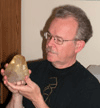
Joined: 29 Dec 2008
Posts: 846
Location: Northeast Ohio



|
 Posted: Aug 20, 2012 14:48 Post subject: Re: About cyclic twinning - (5) Posted: Aug 20, 2012 14:48 Post subject: Re: About cyclic twinning - (5) |
|
|
| mihailovici79 wrote: | | Is this an example of cyclic twinning? |
Well, it's certainly an example of repeated twinning involving three individuals. I probably would not disagree with calling it cyclic twinning, though some probably would because it does not make a complete cycle (hexagonal in this case).
_________________
Collecting and studying crystals with interesting habits, twinning, and epitaxy |
|
| Back to top |
|
 |
alfredo
Site Admin

Joined: 30 Jan 2008
Posts: 1014



|
 Posted: Aug 20, 2012 15:15 Post subject: Re: About cyclic twinning - (5) Posted: Aug 20, 2012 15:15 Post subject: Re: About cyclic twinning - (5) |
|
|
Many thanks to Peter for taking the time to explain these things! Much appreciated by those like myself who were weak in crystallography and have much to brush up on.
I was told that these amesite crystals represent "6-fold sector twinning". Is that a type of "cyclic twin"? (Thanks to the photographer, Saul Krotki.)
On another note, I think that many complex and multiple Japan-law twin quartzes disprove the notion that twinning had to start at the onset of crystal growth. When one sees Japan-law twins whose members are very different in size, with the smaller one jutting out halfway up the prism of its larger partner, or even multiple "juniors" at different positions on a larger member, it's hard to see how this could have all formed at the initiation of growth.
| Description: |
Amesite-2H
Cerro Sapo, Cochabamba, Bolivia
xl terminations <0.2mm wide |
|
| Viewed: |
71565 Time(s) |
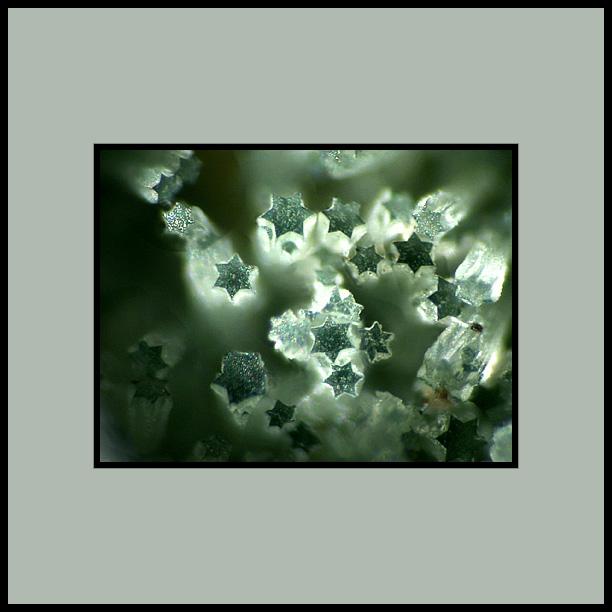
|
|
|
| Back to top |
|
 |
Jordi Fabre
Overall coordinator of the Forum

Joined: 07 Aug 2006
Posts: 5095
Location: Barcelona



|
 Posted: Aug 20, 2012 15:51 Post subject: Re: About cyclic twinning - (5) Posted: Aug 20, 2012 15:51 Post subject: Re: About cyclic twinning - (5) |
|
|
| Pete Richards wrote: | | ...though some probably would because it does not make a complete cycle (hexagonal in this case) |
Here you have an example of a complete cycle.
Great thread by the way!
| Description: |
Rutile (cyclic twinning)
Magnet Cove, Hot Spring County, Arkansas, USA
Specimen size: 2.6 × 2.4 × 2.9 cm.
Former collection of Folch duplicates, currently in the John S. White collection |
|
| Viewed: |
71664 Time(s) |
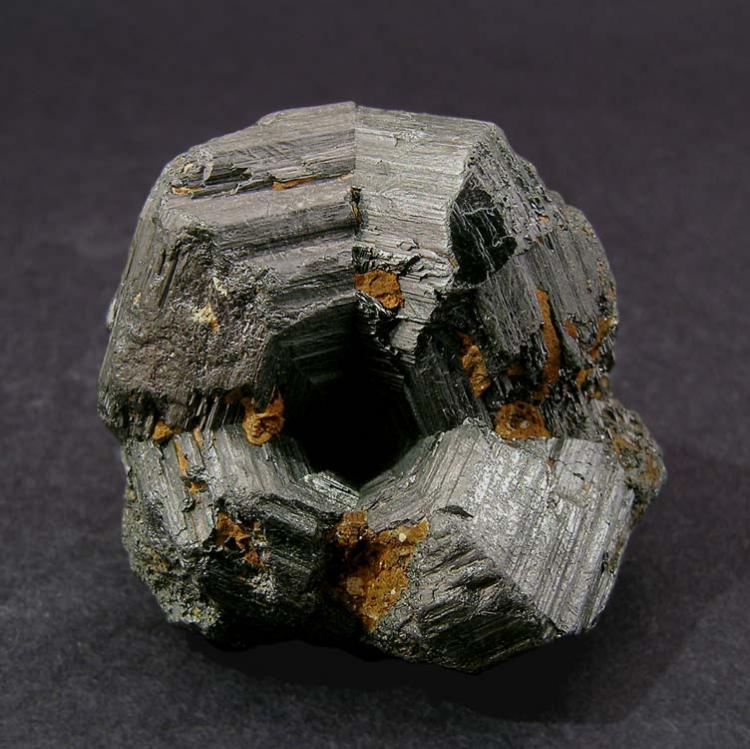
|
|
|
| Back to top |
|
 |
Peter Farquhar
Site Admin

Joined: 14 May 2011
Posts: 52
Location: Virginia



|
 Posted: Aug 20, 2012 18:16 Post subject: Re: About cyclic twinning - (5) Posted: Aug 20, 2012 18:16 Post subject: Re: About cyclic twinning - (5) |
|
|
As my first post on FMF, I’d like to join the discussion about rutile crystals and cyclic twinning.
“Cyclic twinning” is typically defined as “the repeated twinning of three or more individual crystals according to the same twin law, but with the twin axes not parallel.” (e.g., see mindat glossary and other sources). On the other hand, such repeated twinning is called “polysynthetic” if the twinning axes are parallel.
It may seem surprising, but loop closure is not a characteristic for cyclic twinning under this definition. While Ford points out in Dana’s Textbook, this “repetition of twinning tends to produce circular forms” under certain conditions, he also acknowledges the zig-zag shaped twins from “repeated geniculations.”
Therefore, the category of “cyclic twins” for rutile includes both complete (closed-looped) and incomplete (open-loop) sixlings, eightlings, and other n-sided specimens, as well as the (non-loop) geniculated crystals that zig and zag in successive directions.
Challenge #1: Cyclic twinning is common in rutile, but polysynthetic twinning is rather uncommon in rutile. Here is an example of both types in one specimen. The Brazilian rutile specimen below illustrates both cyclic twinning (a partial sixling) and polysynthetic twinning (a doublet). Considering the earlier discussion in this thread, how did this crystal form?
Challenge #2: Magnet Cove Arkansas has produced some wonderful rutile eightlings. Below is a specimen shows an eightling that is part of a larger eightling. What do you call this cyclic twinned rutile? How did this crystal form?
Please let me know if you’d like to see more challenges.
Peter Farquhar
Claremont, California
USA
| Description: |
Rutile
Pirenopolis, Goias, Brazil
4.3 x 4.5 x 4.0 cm
Rutile with both cyclic and polysynthetic twinning (PF-3349) |
|
| Viewed: |
71498 Time(s) |
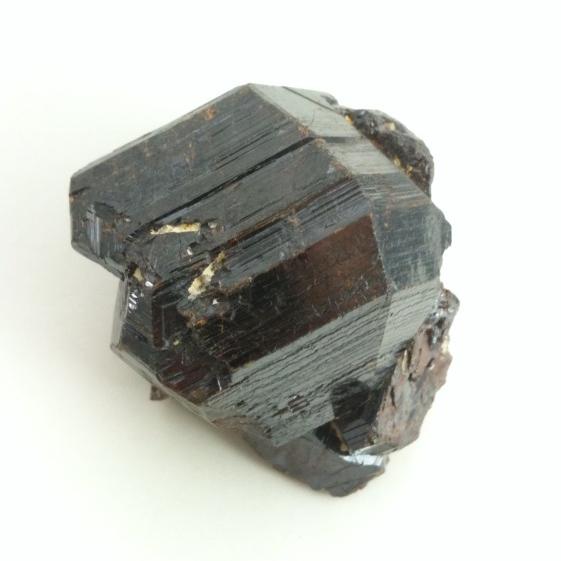
|
| Description: |
Rutile
Magnet Cove, Hot Spring Co., Arkansas, USA
3.0 x 2.3 x 1.3 cm
Rutile eightling within eightling (PF-3208). |
|
| Viewed: |
71531 Time(s) |
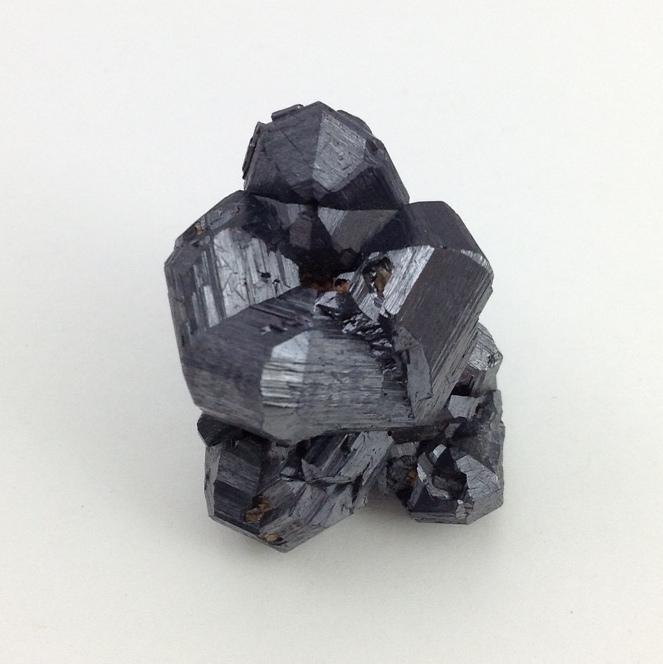
|
|
|
| Back to top |
|
 |
Dean Allum

Joined: 27 Jan 2010
Posts: 17
Location: Colorado


|
 Posted: Aug 20, 2012 23:56 Post subject: Re: About cyclic twinning - (5) Posted: Aug 20, 2012 23:56 Post subject: Re: About cyclic twinning - (5) |
|
|
| Pete Richards wrote: | | Dean Allum wrote: | Pete,
Your competing poly-crystals theory for cyclic twinning is elegant!
Wouldn't there be some remaining evidence of the nucleation site at the central vertex which you could view with a TEM of the thin section?
-Dean Allum |
Thanks!
There might be some evidence of the nucleation site, though the nucleus might be too small to see except with something like TEM. If the crystal is not highly transparent, finding the nucleation site would be quite a challenge - there's no guarantee it would be in the physical center of the twin! |
Which is why you would use the thousands of small transparent sixlings that are probably abundant in the rutile sands which are a commercial product. There is now an analytical technique called Focused Ion Beam (FIB) which is capable of slowly etching material with about 100 atom accuracy. It is technically possible to verify your theory.
|
|
| Back to top |
|
 |
Peter Farquhar
Site Admin

Joined: 14 May 2011
Posts: 52
Location: Virginia



|
 Posted: Aug 22, 2012 19:58 Post subject: Re: About cyclic twinning - (5) Posted: Aug 22, 2012 19:58 Post subject: Re: About cyclic twinning - (5) |
|
|
The rutile sixling from Atglen, Pennsylvania shown below looks almost identical to the purple 3-D drawing that Pete Richards posted earlier.
Peter Farquhar
Claremont, California
USA
| Description: |
Rutile
Atglen, Lancaster County, Pennsylvania, USA
2.1 x 2.1 x1.5 cm
A complete rutile sixling from Pennsylvania (PF-3147). |
|
| Viewed: |
42028 Time(s) |
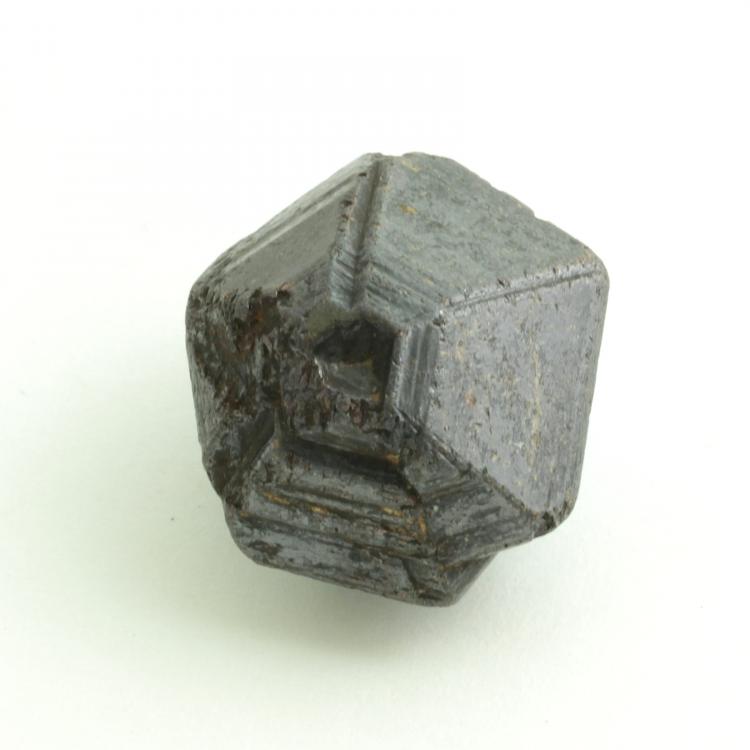
|
|
|
| Back to top |
|
 |
Pete Richards
Site Admin

Joined: 29 Dec 2008
Posts: 846
Location: Northeast Ohio



|
 Posted: Aug 22, 2012 20:57 Post subject: Re: About cyclic twinning - (5) Posted: Aug 22, 2012 20:57 Post subject: Re: About cyclic twinning - (5) |
|
|
| RutileFox wrote: | | The rutile sixling from Atglen, Pennsylvania shown below looks almost identical to the purple 3-D drawing that Pete Richards posted earlier. |
Wow! That's amazing! I've never seen a real rutile twin that was so close to the theoretical morphology. Thanks for posting it. (I covet it, but will have to settle for the image.)
_________________
Collecting and studying crystals with interesting habits, twinning, and epitaxy |
|
| Back to top |
|
 |
gemlover

Joined: 31 Dec 2008
Posts: 211
Location: Easley, SC



|
 Posted: Aug 22, 2012 23:35 Post subject: Re: About cyclic twinning - (5) Posted: Aug 22, 2012 23:35 Post subject: Re: About cyclic twinning - (5) |
|
|
Great and beautiful specimen. And from Atglen, I lived in both Chester and Lancaster counties in that area.
John
_________________
John
John Atwell Rasmussen, Ph.D.. AJP
Geologist and Gemologist |
|
| Back to top |
|
 |
Peter Farquhar
Site Admin

Joined: 14 May 2011
Posts: 52
Location: Virginia



|
 Posted: Aug 25, 2012 19:14 Post subject: Re: About cyclic twinning - (5) Posted: Aug 25, 2012 19:14 Post subject: Re: About cyclic twinning - (5) |
|
|
Another perspective on cyclic twinning in rutiles:
The photographic plate below is from Louis Pope Gratacap’s famous 1912 book, "A Popular Guide to Minerals." The black-and-white plate nicely illustrates different forms of cyclic twinning with three Pennsylvania rutile specimens. Gratacap selected these rutiles from the Clarence S. Bement collection in the American Museum of Natural History, where Gratacap served as the Curator of Mineralogy in the early 1900s.
In 1907, Gratacap used this same plate for another purpose in a short article he published on mineral photography in the "American Annual of Photography 1908." Gratacap was experimenting at the time with different lighting techniques and camera lens, and chose these rutile specimens to illustrate the many challenges in photographing cyclic twins. But little has changed more than a century later. Wendell Wilson recently commented that rutiles “are one of those minerals that are very difficult to photograph, and the worst of the lot are the cyclic twins …” (Axis, 2005).
With these warnings in mind, I tried to recapture in the 2012 color image shown below the same Parkesburg rutile specimen figured on the right side of Gratacap’s 1907 plate. A side-by-side comparison of these two images reveals the complex challenges in portraying the “geniculated oscillations” that Gratacap wrestled with over a century ago.
Peter Farquhar
Claremont, California
USA
| Description: |
Rutiles
Parkesburg, Chester County, Pennsylvania USA
L. P. Gratacap photo of three Clarence S. Bement rutile specimens from the American Museum of Natural History in New York City (1907) |
|
| Viewed: |
41769 Time(s) |
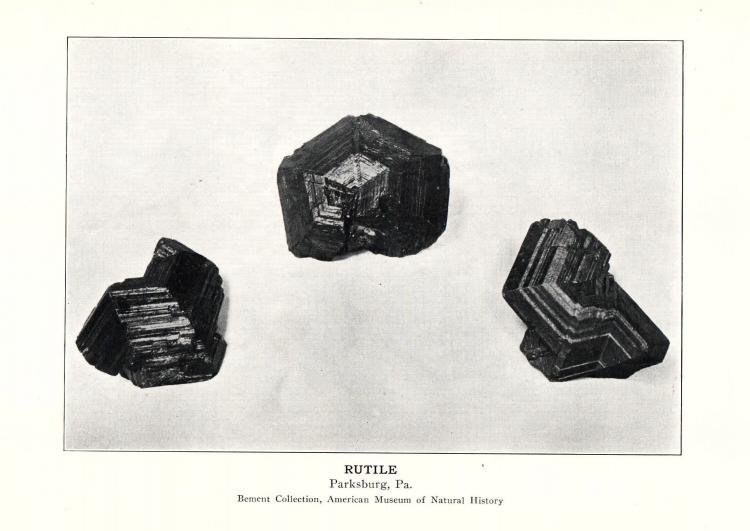
|
| Description: |
Rutile
Parkesburg, Chester County, Pennsylvania USA
5.0 x 3.4 x 2.8 cm
Comparison of the same cyclic twinned rutile specimen (PF-1781 ) as photographed in 1907 vs. 2012. |
|
| Viewed: |
41746 Time(s) |
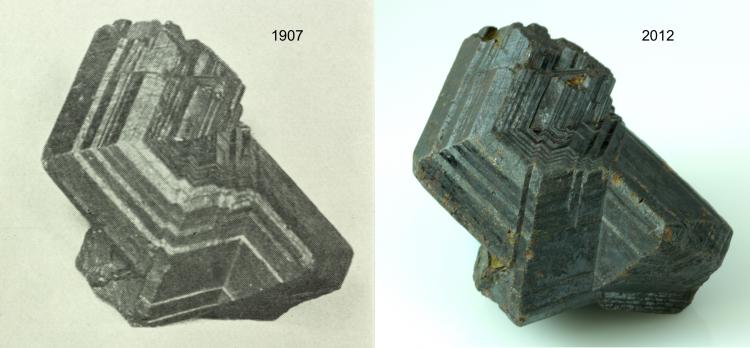
|
|
|
| Back to top |
|
 |
John Jaszczak

Joined: 05 Oct 2010
Posts: 300
Location: Hancock, MI



|
 Posted: Aug 27, 2012 17:57 Post subject: Re: About cyclic twinning - (5) Posted: Aug 27, 2012 17:57 Post subject: Re: About cyclic twinning - (5) |
|
|
| Nicely done!
|
|
| Back to top |
|
 |
Peter Farquhar
Site Admin

Joined: 14 May 2011
Posts: 52
Location: Virginia



|
 Posted: Sep 18, 2012 17:24 Post subject: Re: About cyclic twinning - (5) Posted: Sep 18, 2012 17:24 Post subject: Re: About cyclic twinning - (5) |
|
|
| Tracy wrote: | I recently saw an image of a rutile specimen described as a cyclic twin, however the specimen wasn't round - rather, it looked like a series of steps or a "w" with a few extra bends (vvv-like). Was this an accurate description? I would expect a cyclic twin to be cyclic (= ring-shaped), but was wondering what are the criteria?
... The specimen I saw has six distinct faces, appears to be planar or nearly so, and originates from Diamantina.
- Tracy |
After a lengthy search, I found a specimen that fits Tracy’s description at the beginning of this thread. With the kind permission of the photographer, I’m able to post images of this rutile specimen from Diamantina, Brazil on FMF. (Tracy, is this the image you saw?)
I’m not sure we answered Tracy’s original question correctly, so I’d like to reopen the discussion on this thread using this image.
The question for the Forum is how would you describe the twinning exhibited by this rutile specimen below? In particular, does it meet the criteria discussed for a cyclic twin?
I’d describe this specimen as a group of intergrown V-twins of rutile, but not a cyclic twinned rutile. One reason is that this rutile does not appear to exhibit repeated twinning. I’d really like to know what others think about this interesting puzzle.
Peter Farquhar
Claremont, California
USA
| Description: |
Rutile (front view)
Diamantina, Brazil
1.5 x 0.5 x 0.4 cm
Photo by Heliodor; used with permission. |
|
| Viewed: |
41599 Time(s) |
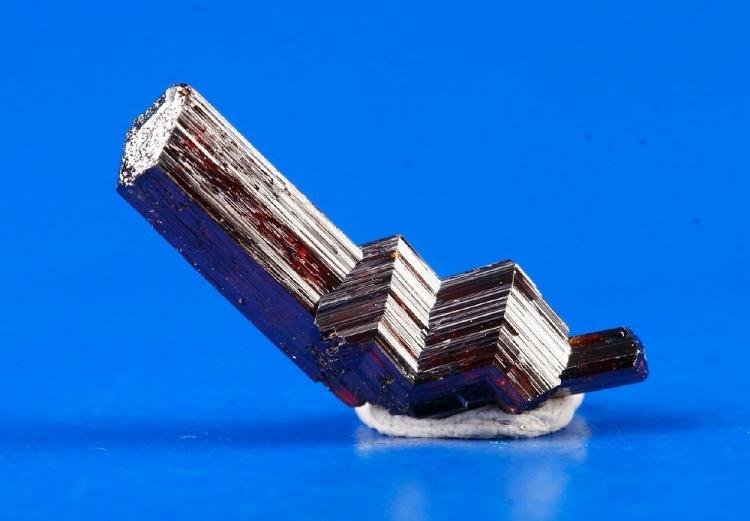
|
| Description: |
Rutile (rear view)
Diamantina, Brazil
1.5 x 0.5 x 0.4 cm
Photo by Heliodor; used with permission. |
|
| Viewed: |
41376 Time(s) |
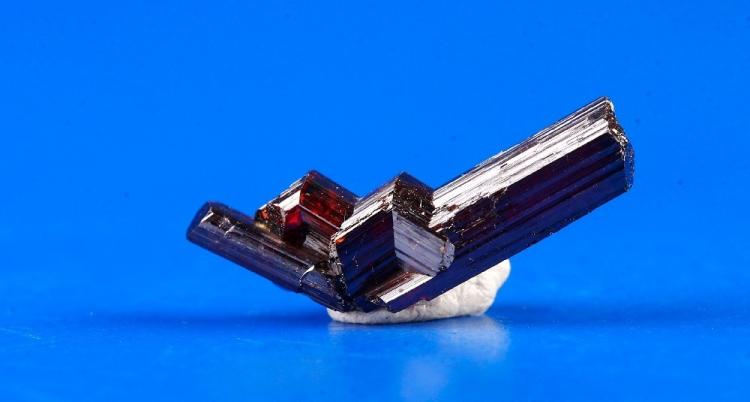
|
|
|
| Back to top |
|
 |
Tracy

Joined: 15 Sep 2006
Posts: 551
Location: Toronto



|
 Posted: Sep 19, 2012 06:47 Post subject: Re: About cyclic twinning - (5) Posted: Sep 19, 2012 06:47 Post subject: Re: About cyclic twinning - (5) |
|
|
| RutileFox wrote: | | Tracy wrote: | I recently saw an image of a rutile specimen described as a cyclic twin, however the specimen wasn't round - rather, it looked like a series of steps or a "w" with a few extra bends (vvv-like). Was this an accurate description? I would expect a cyclic twin to be cyclic (= ring-shaped), but was wondering what are the criteria?
... The specimen I saw has six distinct faces, appears to be planar or nearly so, and originates from Diamantina.
- Tracy |
After a lengthy search, I found a specimen that fits Tracy’s description at the beginning of this thread. With the kind permission of the photographer, I’m able to post images of this rutile specimen from Diamantina, Brazil on FMF. (Tracy, is this the image you saw?)
|
Peter, that's the one! - you beat me by a day, I was about to try my hand at photographing it since it's now mine. :-)
Looking at all the illustrations provided, and reading through the comments, I still don't have a clear answer. And now Peter has added photos. Is this specimen a cyclic twin?
(I'm surprised to read that rutile doesn't undergo cyclic twinning, this seems inconsistent with other posts and images)
- Tracy
_________________
"Wisdom begins in wonder" - Socrates |
|
| Back to top |
|
 |
Tracy

Joined: 15 Sep 2006
Posts: 551
Location: Toronto



|
 Posted: Sep 20, 2012 06:54 Post subject: Re: About cyclic twinning - (5) Posted: Sep 20, 2012 06:54 Post subject: Re: About cyclic twinning - (5) |
|
|
Um...so that's one vote for yes, and one vote for no? I'm really confused.
- Tracy
_________________
"Wisdom begins in wonder" - Socrates |
|
| Back to top |
|
 |
Pete Richards
Site Admin

Joined: 29 Dec 2008
Posts: 846
Location: Northeast Ohio



|
 Posted: Sep 20, 2012 10:37 Post subject: Re: About cyclic twinning - (5) Posted: Sep 20, 2012 10:37 Post subject: Re: About cyclic twinning - (5) |
|
|
| RutileFox wrote: | | The question for the Forum is how would you describe the twinning exhibited by this rutile specimen below? In particular, does it meet the criteria discussed for a cyclic twin? |
A very interesting specimen!
I would not call it a cyclic twin, because in my opinion a zig-zag twin shows repeated but not cyclic twinning. But this crystal seems to hide some other secrets, revealed by the second photo. It appears to show that this is actually at least three and probably four separate crystals, two (or maybe three) of them v-twins, as Peter said. These individual crystals/twins have grown into each other as they got larger.
If this is correct, how did they manage to assume parallel orientations?!!! I like to think that these kinds of twins - and many sagenite arrays - are actually examples of epitaxy (probably on ilmenite or hematite) in which the host weathered away, perhaps before the rutile stopped growing. I have examples of rutiile pseudomorphs after ilmenite(?) from Mont Saint-Hilaire which are almost perfect hexagonal plates, but with microtextures that demonstrate that they are aggregates of oriented crystals. SEM/EDS shows that they contain only titanium and oxygen - no iron!
| Description: |
Rutile (sagenite)
Erdgestollen Obergesteln, Goms, Wallis, Switzerland
3 cm group
Naturhistorisches Museum Basel specimen, Erich Offermann photograph |
|
| Viewed: |
41200 Time(s) |
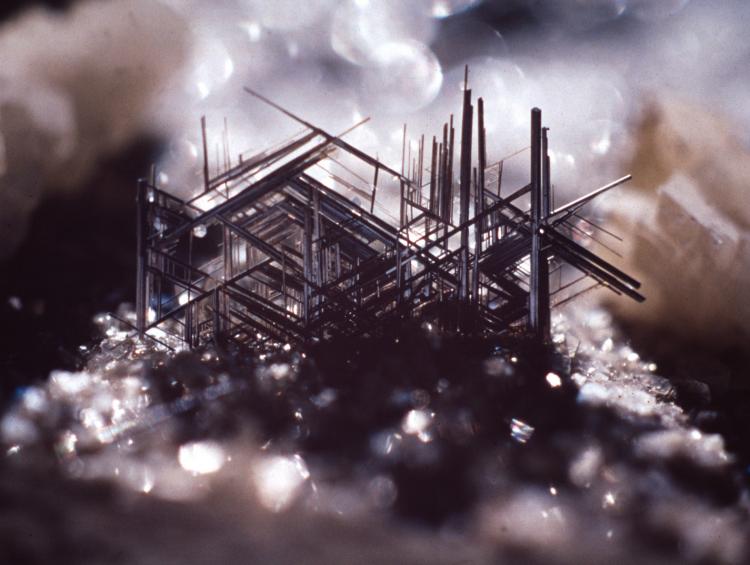
|
| Description: |
Rutile (sagenite)
Lamme, Ernen, Binntal, Wallis, Switzerland
Field of view 28 mm tall
Naturhistorisches Museum Basel specimen, Erich Offermann photograph |
|
| Viewed: |
41192 Time(s) |
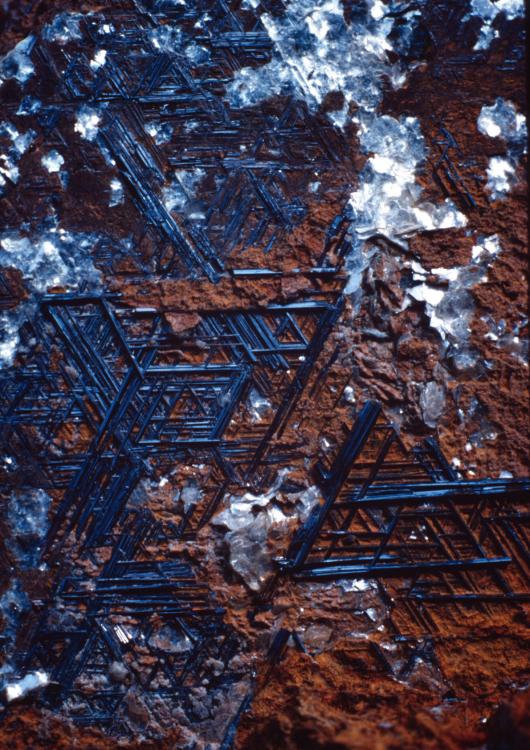
|
| Description: |
Rutile after ilmenite(?)
Poudrette Quarry, Mont Saint-Hilaire, Quebec, Canada
0.5 mm crystal |
|
| Viewed: |
41160 Time(s) |
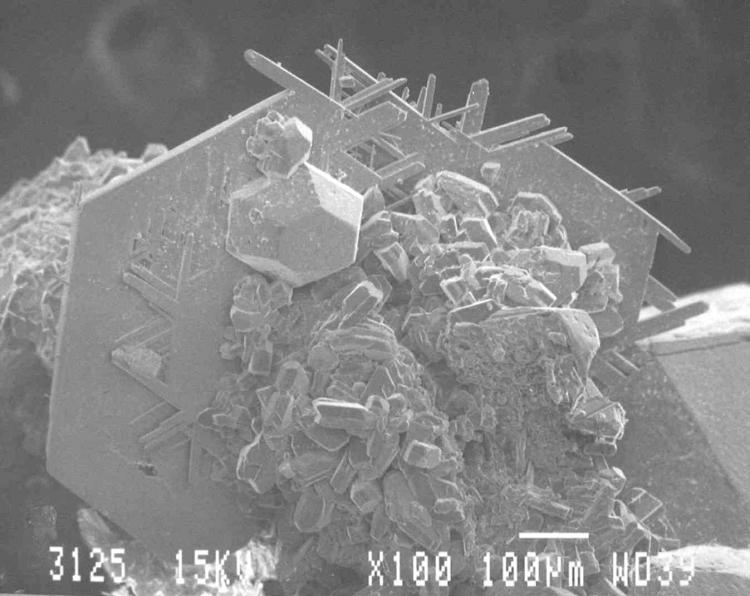
|
| Description: |
Rutile after ilmenite(?)
Poudrette Quarry, Mont Saint-Hilaire, Quebec, Canada |
|
| Viewed: |
41172 Time(s) |
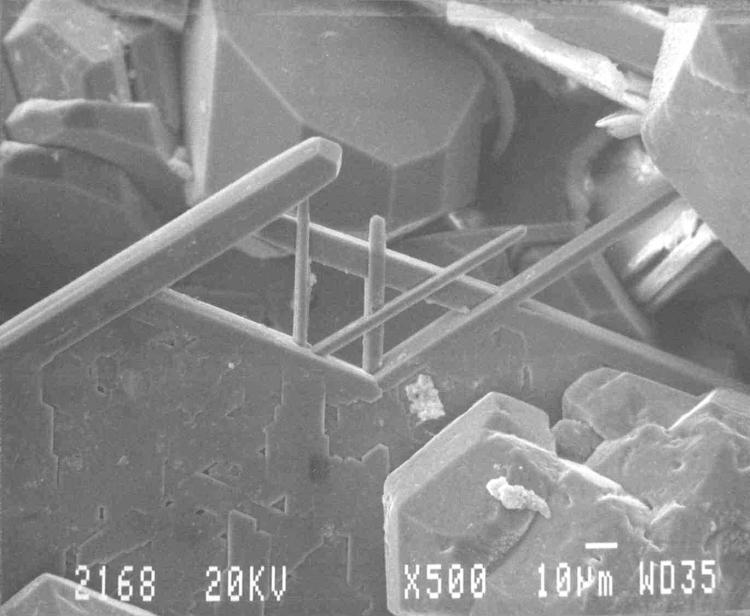
|
_________________
Collecting and studying crystals with interesting habits, twinning, and epitaxy |
|
| Back to top |
|
 |
Tracy

Joined: 15 Sep 2006
Posts: 551
Location: Toronto



|
 Posted: Sep 20, 2012 11:25 Post subject: Re: About cyclic twinning - (5) Posted: Sep 20, 2012 11:25 Post subject: Re: About cyclic twinning - (5) |
|
|
Would other photo angles be helpful? I should have time this weekend.
Thanks Pete and Peter! The suggestion of intergrown v-twins makes sense to me.
[Puzzles make me happy. :-)]
- Tracy
_________________
"Wisdom begins in wonder" - Socrates |
|
| Back to top |
|
 |
|





